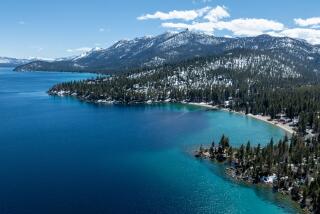Melting down
- Share via
After years of intermittent skirmishing, the ski industry and environmentalists worldwide have found an enemy they can denounce together: overheated winters. The moguls’ motivation is made clear in a report from Swiss researchers, released in Turin, Italy, on Dec. 2 to broad media attention. It suggests that a 3-degree rise in Fahrenheit temperatures worldwide in the next 50 years -- which many experts say is a conservative projection -- could melt away business at scores of the world’s best-known resorts, driving smaller operators out of the market and sending the survivors in search of snow-making machinery or higher, colder ground.
Released at a conference sponsored by the United Nations Environment Program and the International Olympic Committee, the study predicts that snow in relatively low-lying mountain resort areas, especially those fewer than 4,900 feet above sea level, will become increasingly unreliable in coming decades. Though some resorts may protect themselves through snow-making, researchers say the costs of buying and using that machinery are too high for most.
In Switzerland, the authors say, about 36 of the country’s 230 ski resorts now have unreliable levels of snowfall. But if the warming predicted by many experts comes, they say, the “reliable” snow line could rise from roughly 3,900 feet to 4,900 in the next 30 to 50 years, leaving 85 of the country’s resorts without reliable slope coverage. If the snow line rises to 5,900 feet -- which researchers see as possible but less likely -- 129 of the country’s ski resorts could find themselves snow-poor. In Germany or Austria, where resorts tend to stand at lower altitudes, results could be more severe.
With the exception of Sun Valley (at 5,750 feet), most major resorts in the Western U.S. have bases above 6,700 feet. Mammoth Mountain’s base is 7,953 feet, the Big Bear resorts’ bases are between 6,700 feet and 7,140.
These forecasts are built upon the widely held view among scientists -- challenged by a few scientists and many U.S. legislators -- that the Earth is warming and that human activities such as burning fossil fuels and cutting down trees are prompting this change.
The findings were compiled by three researchers based at the University of Zurich, drawing on a forecast by the Intergovernmental Panel on Climate Change that, given current conditions, a temperature increase of 2.5 to 10.4 degrees Fahrenheit between now and 2100 is likely.
The study echoes alarms from U.S. resort operators, many of whom have tussled in the past with green activists over such issues as land and water use and endangered species.
In February, the National Ski Areas Assn. unveiled a “Keep Winter Cool” campaign -- a joint venture with the Natural Resources Defense Council, or NRDC -- aimed at highlighting measures to reduce air pollution. (At Mammoth Mountain, for instance, management has added solar heating to lift shacks.)
Then in October, three dozen U.S. resorts threw their support behind an emission-limiting Climate Stewardship Act proposed by U.S. Sens. John McCain (R.-Ariz.) and Joseph Lieberman (D.-Conn.). The bill failed on a 55-43 Senate vote Oct. 30.
American ski resorts “have really keyed in on the fact that global warming is having impacts on their bottom line and will keep doing so unless we use solutions like driving cleaner cars,” said Eben Burnham-Snyder, deputy communications director of the NRDC’s climate center in Washington. Though “there have been some disagreements between the environmental community and the ski industry,” he said, their common interests on warming made teaming up a “no-brainer.”
In Europe, the report notes, some resort boosters have called for government subsidies to sustain them and concludes that “the tourism representatives will not just sit back idly in the face of climate change.... Tourists demand good snow conditions, and hence, this is what has to be offered by the ski resorts.”







